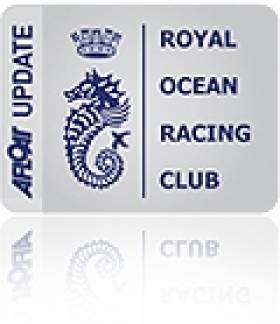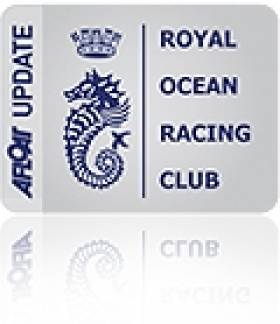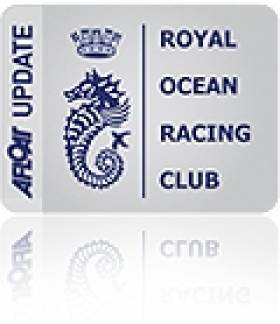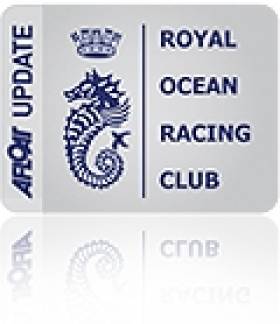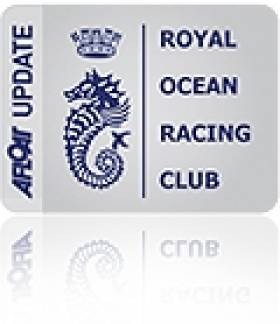Displaying items by tag: RORC
Global Fleet Gather for RORC Caribbean Rendezvous
#rorc – An amazing fleet of yachts from around the globe, have come together for a spectacular Caribbean rendezvous and there are some key Irish crew involved writes Louay Habib. Fort Charlotte, Antigua will be the starting and finishing point for a sensational 600-mile yacht race around 11 Caribbean islands.
From Ireland, the Royal Irish Yacht Club's Tim Goodbody (junior) will be racing on Windfall. James Carroll (ex–boat captain of Green Dragon) will be captain on the Carkeek 47 Black Pearl. Simon Johnson is racing on Leopard 3.
James Carroll has been with the Carkeek 47, Black Pearl, since launch June last year. It's a ful spec offshore boat that rreviously competed in the Palermo to Monte Carlo Race and Middle Sea Race last year. It has a full offshore programme again this year, starting with this week's Carribbean 600. Carroll is both boat captain and pitman.
Two other Irish sailing in the Caribbean 600 are Paul O'Donoghue from Lough Derg Yacht Club, son of Geoff O'Donoghue and Gordon Spain from West Cork. They are both on GB entry LIARA, owned by Tony Todd.
Since 2009, the RORC Caribbean 600 has been growing in popularity and the seventh edition boasts an astounding fleet of yachts: record breaking high performance racers, magnificent schooners, elegant classics and fast production yachts. World class sailors will be taking part, rubbing shoulders with royalty, captains of industry and passionate Corinthian amateurs. (Latest entry list 64 boats)
The course meanders through the stunning central Caribbean affording amazing scenery, but the RORC Caribbean 600 is not just a joyride. Competitors can expect little sleep as the myriad of corners create many manoeuvres. The racing is electric but the high speed action in tropical heat can be exhausting. At the finish, the welcome party for the crews has become legendary. Every boat is cheered in, regardless of the hour, for a cold beer and a warm welcome. (Follow the fleet. The race tracker will be live before the start here.
The monohull course record for the RORC Caribbean 600 (40 hours 20 mins 02 secs) was set by George David's Rambler 100 in 2011. The quality and depth of the fleet in this year's race means that the quest for line honours will be the most dramatic in years.
The overall winner is decided by the RORC IRC rating system and the calibre of the fleet is such that this year's winner is almost impossible to predict. Teamwork, tactics, and a share of good luck will decide the winner. Over the past six editions, only one 100-footer has won the race overall: Rambler 100. High performance yachts ranging from 50-72 feet have won the RORC Caribbean 600 Trophy on four occasions.
This year three projects, new to the race, will fit into that category: Bryon Ehrhart from Chicago, Illinois, will be racing Reichel Pugh 63, Lucky. Piet Vroon's newly acquired Ker 51, Tonnerre 4, from Breskens, Netherlands and British TP52 Sorcha, sailed by Peter Harrison, make up a trio of yachts that will be amongst the favourites for overall victory under the IRC rating rule.
The seventh edition of the RORC Caribbean 600 has entries from over 14 different nations and crew from many more. Throughout the fleet there is a myriad of class champions from famous yacht races around the world.
UNITED STATES OF AMERICA
George David's brand new hi-tech 88ft Rambler is now in Antigua, hoping to lower the bar for the course record for the RORC Caribbean 600. Previous Ramblers still hold course records for: RORC Caribbean 600, The Transatlantic Race, Newport to Bermuda Race and Rolex Middle Sea Race. Amongst Rambler's international crew are numerous world champions including three well-known sailors from New Zealand: Multiple America's Cup winner, Brad Butterworth and Volvo Ocean Race winners, Stu Bannatyne and Brad Jackson.
Yachts from the USA have won the RORC Caribbean 600 overall on three occasions, more than any other nation. From Boston, Massachusetts, Ron O'Hanley's Cookson 50, Privateer, was the overall winner under IRC in 2013 and the American team is back for their fifth race, having won IRC Canting Keel last year. From Minneapolis, Minnesota, Hap Fauth will be racing his world championship winning Maxi 72, Bella Mente, the overall runner up for the race on two occasions. This year Bella Mente's crew includes Mike Sanderson, Terry Hutchinson, Ian Moore and Adrian Stead. Bella Mente will be hoping it will be third time lucky in their quest for first place.
Two American flyers will be making their RORC Caribbean 600 debuts: Doug Baker from Orange County, California will be racing Kernan 47, True, and from Houston, Texas William Coates' Ker 43, Otra Vez will have Volvo Ocean Race sailors George Peet and Luke Molloy on board. Stefan Jentzsch's German Carkeek 47, Black Pearl, also makes its debut, with South African America's Cup navigator, Marc Lagesse, amongst the crew.
Three American classic yachts will be on the start line on February 23rd: James Grundy of Oxford, Maryland will be racing the 84 year-old Alden schooner, Summerwind. The 1938 S&S Yawl Black Watch will sailed by Joseph Robillard of Short Hills, New Jersey and Frank Eberhart from Vinalhaven, Maine will be racing for the third time with the 1970 classic, Hound.
ITALY
Volvo 70 Maserati is skippered by the legendary Italian sailor from Milan, Giovanni Soldini. Maserati is designed to break records and holds the Cadiz-San Salvador, New York-San Francisco and the Cape Town-Rio de Janeiro race[BB2] records. On board for the RORC Caribbean 600 will be Pierre Casiraghi, eldest son of Princess Caroline of Monaco, fourth-in-line to the Monegasque throne and a passionate sailor. Maserati's owner John Elkann will also be racing. The Grandson and heir of Giovanni Agnelli, John Elkann is the President of Fiat Chrysler Automobiles which owns the Maserati brand, as well as Ferrari, Alfa Romeo and many others.
GREAT BRITAIN
London based property developer Mike Slade's Canting Keel Maxi, Leopard, set the course record in the inaugural race and holds numerous speed and race records, including two current Transatlantic races. This year, Leopard has been chartered by UK-based businessman Chris Bake, winner of five RC44 Tour Championships. The core Leopard crew, including Australian skipper Chris Sherlock, will form a formidable partnership with Bake's Team Aqua. The all-star crew includes America's Cup winner Cameron Appleton from New Zealand and Volvo Ocean Race winner Jules Salter from Gurnard, Isle of Wight.
RORC Admiral and London surgeon, Andrew McIrvine will be taking part in his sixth race and skippers Southern Wind 94, Windfall. The vast majority of Windfall crew will be RORC members, including Dublin based RORC Commodore, Michael Boyd as navigator. Two RORC Rear Commodores will also be on board: Justin Slawson from Wimborne, Dorset and Adrian Lower from Burnham-on-Crouch, Essex. Windfall should have a fascinating battle with PY100, Liara, owned by Tony Todd from St. Peter Port, Guernsey and sailed by John Walker from Romsey, Hampshire. Liara's crew include a number of Hampshire's most experienced yachtsmen including Peter Morton and Kelvin Rawlings from Cowes, Isle of Wight and navigator, Nat Ives from Hamble-le-Rice, Hampshire.
British Volvo 70 Monster Project will be skippered by Andy Budgen from Greenock, Scotland. Monster Project took Line Honours for the Canting Keel Class last year and is a real flyer in Caribbean conditions. Monster Project is one of 10 specialist race charter yachts competing. Well over 100 passionate amateur sailors will be taking up the challenge against the professionals, racing on performance charter yachts.
Last year First 40 Lancelot II, skippered by Chris Jackson from Fareham, Hampshire, was the winner of IRC Two which contains the bounty of race charter yachts. Ross Applebey from Wallingford, Oxfordshire will skipper Oyster 48 Scarlet Oyster, which has won class in the RORC Caribbean 600 on two occasions. Racing for the sixth time, Andy Middleton from Cowes, Isle of Wight will skipper First 47.7 EH01.
Antigua is the Caribbean home of two of the world's most famous schooners. Athos and Adela will continue their gentlemen's duel in the Spirit of Tradition class. The Dykstra-designed Adela is the smaller of the two magnificent yachts at 182ft and over 200 tons. The sails and systems on board Adela are advanced, but manoeuvres such as handling her giant red 1000m2 masthead spinnaker can require up to 30 crew. Athos is the largest yacht competing this year's RORC Caribbean 600. The 203ft Hoek design weighs 370 tons, her rig is over 200ft high and she can hoist over 3000m2 of sail. Adela has won the Spirit of Tradition and Superyacht Classes for the last three years, but Athos provided exhilarating competition last year, finishing less than 39 minutes behind after two and a half days at sea.
By sharp contrast with the two largest yachts racing, local dentist Bernie Evan-Wong will be racing one of the smallest, his new Reichel Pugh 37 Taz. Bernie has competed in every RORC Caribbean 600 race since it started in 2009. "The RORC Caribbean 600 race captured my imagination the first time I heard about it," exclaimed Bernie Evan-Wong. "The thought of full-on racing, night and day in tropical waters for 600 miles was a challenge and an adventure I just could not resist! If you love sailing and are a serious sailor, you have to put the RORC Caribbean 600 on your itinerary."
Irish Sailors In Command of International Sailing in London
#rorc – London's unique position at the crossroads of world sailing communications makes it a focus of attention in the winter months. Organisations of international standing will be having key administrative and decision-making meetings in the short non-sailing winter days, decisions which will impact on the coming season and the years beyond.
Sailing's world body, the International Sailing Federation, may take itself off in November to some choice destination resort for a week-long conference, with all expenses paid for the selected delegates. But the more specialist organisations rely to varying extents on voluntary workers with limited time and resources. Thus their constitutionally-required yearly gatherings tend to be compressed into just one day for an Annual General Meeting (AGM), with effective sub committees and executive officers being relied on to see that decisions made on that day are implemented through the coming year.
It has been a typical winter season in London with the AGM of the Royal Ocean Racing Club in December, and then January saw the annual log adjudication announcements of the Royal Cruising Club - it's a cruising achievement assessment process which goes back to 1896, while the club itself is far and away the world's most senior cruising organisation, as it dates back to 1880. The RCC meeting was then followed nine days later by the Annual General Meeting of the Old Gaffers Association, founded 1963 and now maturing very well as an international body.
There was nothing at all unusual in the fact of these three meetings being held. But it was unusual that, in all three gatherings, the leading roles were filled by Irish sailors. W M NIXON takes up the story.
When Michael Boyd became Commodore of the Royal Ocean Racing Club on December 1st 2014, it was at the conclusion of a year in which Ireland had performed exceptionally well in the club's international racing programme, with a clear victory in the Brewin Dolphin Commodore's Cup series, while Anthony O'Leary's Ker 39 Antix from Cork became RORC "Yacht of the Year" after a season which included winning the club's National IRC Championship and being Captain's Boat in the Commodore's Cup squad.
But it was steady years of service on committees and in the secondary flag officer roles, rather than Irish success in the club's racing, which led to Michael Boyd's elevation to the top post, allied to his long personal involvement of participation in all the main RORC events, and many minor ones too.
And it was not the first time an Irish sailor has played a key role in this unique organisation. Back in August 1925 at its founding in Plymouth immediately after the first Fastnet Race, one of the seven skippers involved was Harry Donegan of Cork, whose 50ft cutter Gull had placed third overall in what was to prove a turning point in world sailing history.
Although the newly formed Ocean Racing Club was to more or less kidnap the Fastnet Rock to become one of its symbols, Donegan was the only skipper who had raced round it before. He had taken part in the time-honoured contests from Cork Harbour to West Cork, supporting Schull Regatta which dates back to 1884, while Baltimore regatta can probably claim similar longevity. And Harry Donegan knew West Cork well, having been producing privately distributed sailing directions for cruising enthusiasts to its harbours and anchorages since at least 1912.
But inevitably, with the RORC's initial concentration of keen and resource-rich boat-owners sailing from southeast England and focused on London, it was some time before there was another significant Irish presence in the administration of what was gradually developing as world offshore racing's central organization. However, by the 1960s, Denis Doyle of Cork was becoming much involved as a dedicated participant in the RORC offshore programme and on its committee, and by the 1970s he was a Flag Officer.
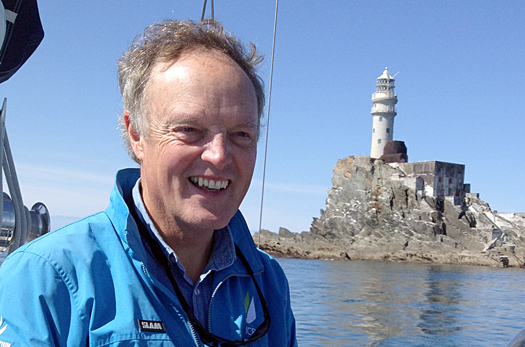
Newly-elected RORC Commodore Michael Boyd at the Fastnet Rock
Yet it was not until 1994 that Ireland provided our first RORC Commodore, John Bourke of Dun Laoghaire. In addition to being a successful offshore skipper in his own right, he had frequently been Denis Doyle's navigator in Moonduster successes, he'd also been a navigator-tactician in Ireland's fourth-placed Admirals Cup tea in 1987's thirteen-team series (our best-ever AC placing, with the Dubois 40 Irish Independent helmed by Tim Goodbody winning the Fastnet overall), and he'd served as President of the Irish Yachting Association.
But John Bourke took over the lead role in the RORC when the times were changing rapidly. Rising costs and the increase in pure professional sailing meant that major international semi-Corinthian events like the Admirals Cup were in rapid decline. And the negative effects of the Fastnet Race disaster of 1979, when 15 lives had been lost, were still being felt in turnouts for RORC events, as much more stringent regulations had led to cost increases and more demanding qualifications for participation. Then too, changing perceptions of the requirements of family life meant that the relatively selfish pattern of offshore racing participants disappearing for frequent long weekends of racing were simply no longer acceptable.
Against that, the RORC had played a key role in co-ordinating and administering the new global International Offshore Rule for handicapping. Then when rapidly evolving boat design and building techniques meant that the IOR was no longer fit for purpose, the RORC was ideally placed to oversee the changeover to the International Rating Certificate (IRC) through experience gained with the administration of the Channel Handicap system, of which elements were kept secret in order to avoid computer-aided exploitation.
So by staying with what it did best, the RORC began to prosper again. As time passed, the sheer horror of the 1979 Fastnet was slowly healed in the memory, so much so that the simple reality is that nowadays, the mythology of '79 adds to the allure of the event. In other words, the entry limit of 340 boats for the Rolex Fastnet Race 2015 was virtually filled within hours of opening. The club really does have a problem of success.
Meanwhile, it has added to the complexity of its shoreside structures by merging with the Royal Corinthian Yacht Club in Cowes. So the RORC is now a club with two clubhouses. There's the historic townhouse HQ in St James's Place in the heart of fashionable London into which it was guided in its early days by ocean racing legend John Illingworth. And there's now a summer place right beside the Royal Yacht Squadron, a rambling building with a colourful history, as members of the Royal Corinthian YC had bought it in the first place from the noted London "hostess" Rosa Lewis, who transferred her boisterous hospitality operations to Cowes during the height of the summer season.
With the new setup possibly being perceived by some members and potential members from other areas and distant nations as too much of a London-Solent nexus, it's interesting to hear that the RORC membership is continuing to increase in a very encouraging way. Clearly, these are exciting times for an organisation of increased global standing, so it's fascinating to note that the two key players in today's RORC administration are keen sailors who took their first serious steps afloat at the same time at two ports just 54 miles apart on each side of the Irish Sea.
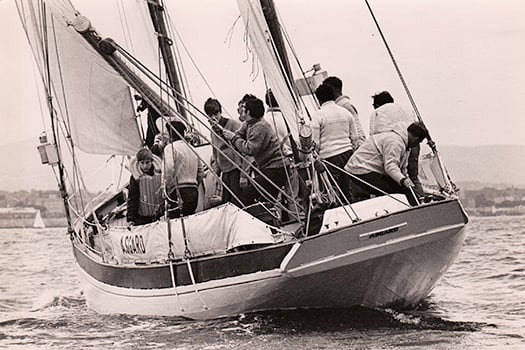
Michael Boyd has his first offshore sailing experience aboard the first Asgard in 1969.
Michael Boyd (64) may work in a demanding London-based international consultancy, and his Irish home may be in the depths of the country in the hidden northern reaches of County Meath, but in sailing terms he's Dun Laoghaire through and through. His father Liam was a stalwart of the Dublin Bay 21 class, and his own first forays offshore were as a youthful trainee aboard the 51ft ketch Asgard under Captain Eric Healy's command during the early days of the historic vessel's six seasons as Ireland's sail training vessel from 1969 to 1974.
At precisely the same time, just across channel in North Wales, his contemporary the young Eddie Warden-Owen was cutting a swathe through dinghy sailing at Treardur Bay and Holyhead. Very quickly, with a GP14 called Gwladys, he was achieving national success, and that in turn led to a career in sail-making and then on to professional sailing at the very top level – his success as coach in making a formerly lacklustre Italian campaign into serious contenders in the America's Cup is now text-book material in advanced sailing courses.

Michael Boyd's choice of a J/35 as his first serious offshore racer was a shrewd decision. He won the Round Ireland Race with the J/35 Big Ears in 1996, and more recently the J/35 has been one of the few exceptional boats to be inducted into American Sailing's Hall of Fame
As for Michael Boyd's sailing career, while it had to be fitted in with hyper-demanding international business commitments, he first really hit the headlines in 1996 with the overall win of the Round Ireland Race with his J/35 Big Ears. He was a regular and successful contender in RORC events, but these days his personal and family boat is through a partnership in the handsome Sparkman & Stephens-designed Maine-built performance cruising ketch Southerly, which is based at New Ross in County Wexford on the tidal section of the River Barrow, while his racing needs were met during 2014 by chartering the Grand Soleil 43 Quokka with fellow RIYC member Niall Dowling.
With Quokka, they were not only a much-valued part of the winning Irish Commodore's Cup team, but were top boat in Cork Week 2014 to win both the Hugh Coveney Cup and the historic 1859-vintage "Kinsale Kettle", a splendidly ornate and substantially-sized bit of Victorian silverware "which we were allowed to sit beside for just about ten minutes – there was no question of taking it home to Lobinstown".
The co-skipper of Quokka (they've chartered her again for 2015) is clearly an enthusiast who relishes our sport, and the ins and outs of sailing in all its ramifications. He makes an ideal person to be Commodore of the RORC at an important juncture in its development, and with Eddie Warden-Owen as the club's CEO, he has a kindred spirit with whom ideas can be developed and implemented at impressive speed.

Eddie Warden-Owen, CEO of the rapidly-developing Royal Ocean Racing Club. He was starting to hone his renowned racing skills at Holyhead just 54 miles across channel from Dun Laoghaire where, at exactly the same time, Michael Boyd was starting his sailing career.
So when your reporter had lunch with the new Commodore just eight days ago, he should have kept the main man strictly on track for a serious discussion of the challenges that club and sport face. And so we did for a while. But when you're with somebody with Michael Boyd's personal enthusiasm for participation sailing, dusty discussions on administrative matters have to run in parallel with wide-ranging and entertaining talk of sailing, boats, sailing folk and the wonders of the sea – the man certainly knows his boats and places and people .
Underneath it all, there was a good impression of the necessary range of his activities – for instance, in the week he became Commodore, he had to be in France for the RORC's Paris Dinner linked to the annual Boat Show there, and he is keenly aware of the club's global spread and the significance of people like Piet Vroon of the Netherlands and the Gouy family of France with their truly international approach to the sport and their regular participation in the Round Ireland Race.
Looking to the west, the club has a strong presence in the Americas, which has been reinforced with the annual RORC Caribbean 600 every February since 2009. This year it will see an uplift in the entries by hundred footers, notably by Syd Fischer's "new hull/original deck and rig" Ragamuffin 100 fresh from the Rolex Sydney Hobart Race, another event in which IRC is the key handicap system.
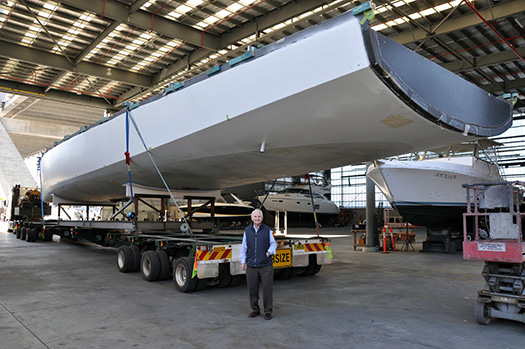
Definitely a sport for life. Syd Fischer, 87-year-old legend of Australian sailing, with the new hull for his hundred footer Ragamuffin just a few months before the recent Rolex Sydney-Hobart Race. Ragamuffin made it in time for the race, she took third on line honours, and now she is being shipped to Antigua to race the RORC Caribbean 600 in February.
But although in Australia the IRC is administered by Hobart race organisers the Cruising Yacht Club of Australia, for the biennial Rolex Fastnet in August and annual Rolex Middle Sea Race from Malta in October, the RORC's Rating Office, based in Lymington under the direction of Mike Urwin, is directly in charge. The Rating Office celebrated 30 years of the IRC Rule in 2014 with a growth in ratings issued after a slight decline during the years of economic recession, and the Lymington unit's unrivalled breadth of experience in the ways of bots and designers and offshore racing give it a special worldwide standing, yet another factor in the RORC's unique position in global sailing.
With their combined experience and proven administrative and international skills, the Boyd/Warden-Owen team are able to provide such formidable leadership for an organization which is central to our sport that they are able to do so in an under-stated way which is ideal for dealing with the highly-individualistic characters who are the leaders in their sport.
So when the London sailing-decision-season started in December with the new setup brought into being in the RORC, clearly things were moving in the right direction. Whether they continued to do so with the next item on the agenda, the Royal Cruising Club awards on January 8th, only time will tell. For this time round, I was the one in the hot seat adjudicating, and you feel the hand of history firmly on your shoulder when you're allocating a trophies which have been won in times past by the likes of Conor O'Brien.
But we'll return to that particular restrospective at the conclusion of this article – meanwhile, how did things go at the Old Gaffers Association AGM last Saturday? Sean Walsh of the Dublin Bay Old Gaffers Association became the first overall president from outside the southeast of England a year ago, so this was the first AGM under his guidance throughout, and it's not a task for the faint-hearted.

Sean Walsh, President of the OGA, sailing in company with the 100ft Viking ship Sea Stalllion.
As the Old Gaffers Association, with its 5,000-plus members in nine countries, is run almost entirely on a voluntary basis, their AGM is virtually a day long affair, a conference really, which started with an intense General Management Committee meeting (the GMC is made up of the Presidents and Hon Secs of each of the many branches) which is a two hour affair which started at 11am and concluded with a brief lunch break before the fully-fledged AGM took up the entire afternoon and went on well into the evening, a four hours-plus session which was to satisfactorily cover an exceptional range of topics.
The OGA may have had fairly casual get-togethers and an annual race or two as its main activities when it was founded in 1963. But now it has evolved into an active group with an impressively developing website and a widespread season-long programme which still has to take account of the notable individuality of the membership and the astonishing variety of their boats.
They even have a very active trailer section in which characterful yet trailerable gaff-rigged boats can suddenly appear in significant numbers at remote sailing locations – the highest lake in Wales, for instance – and they're developing the concept of "Raids" in attractive cruising areas. In these, the fleet keeps together by a relaxed form of racing in which the boat which has got into the lead is only allowed to stay there for five minutes, then she's obliged to go to the back of the fleet. If using the idea for larger slower-manoeuvring boats, you'd probably make the time at the front of the fleet a bit longer, but nevertheless it's a concept of great potential.
As for activities on the sea, while the main focus of 2014 was the Cruise-in-Company in the Netherlands to celebrate the tenth anniversary of the Dutch branch, in 2015 the focus will be on two cruises-in-company, one to St Malo in northeast Brittany to accommodate the large fleet numbers on the south coast of England and on both sides of the southern North Sea, and the other – aimed at the fleets in southwest England and on both sides of the Irish Sea – assembling at Kinsale on July 17th.
This fleet will go on westward for a week centred around the Glandore Classics, though with forays to the Fastnet Rock and other nearby ports. Glandore will then be followed by a further two weeks cruising towards West Kerry with a circuit of Skellig Michael the target, followed by more leisurely cruising homewards. In all, an epic three week venture which, like the OGA's successful Golden Jubilee Round Britain Cruise-in-Company in 2013, will probably see some boats joining and leaving at different intervals, though for most, staying the complete and very scenic course will be the target.
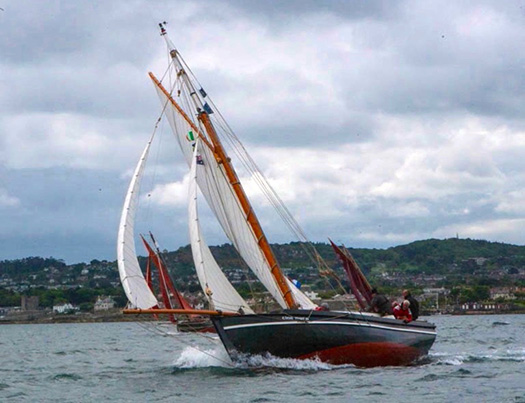
Cine Mara from The Netherlands. Rik Janssen's steel-built version of a traditional Galway Hooker, seen in Dublin Bay during the OGA Golden Jubilee Cruise-in-Company in 2013, was one of the flagships for 2014's Tenth Anniversary Cruise-in-Company for the Dutch Branch of the OGA. She is expected back in Ireland for the 2015 Glandore Classics in July, and the subsequent Old Gaffers Cruise-in-Company to West Cork and Kerry. Photo: Barry O'Loughlin
What with their intense GMC meeting in the morning, closely followed by his four hours and more of moderating the AGM in the afternoon over an exceptional range of topics, Sean Walsh and his team had a busy day of it. But as with any successful body, by the conclusion of the meeting the administrative officers were themselves re-enthused by the energy and commitment of their members. And from the Irish point of view, it certainly means that from July 18th to 24th we're going to have a CH Marine Glandore Classics Regatta 2015 on an unprecedented scale.
By contrast, the Royal Cruising Club works on the notion that small is beautiful. It has only 400 full members, but with a big history going back to 1880 when it was founded in London by a Trinity College Dublin graduate called Arthur Underhill, and its Challenge Cup goes back to 1896, which makes it far and away the world's senior cruising trophy.
In the early days, there were those cruising people who sniffed at the very idea of a "cruising competition". But contests such as this encourage the keeping of proper logs, which is an integral part of seamanship. And in an activity which is remarkably difficult to quantify, qualify and annotate, the story of the many winners gives us an unrivalled narrative of the development of cruising and cruising boats over the past 118 years.
Certainly it's something which the RCC - after some initial and understandable reluctance back in the early days – now takes very seriously indeed, so much so that the identity of the judge is kept an almost complete secret until the announcements go public in early January, and only a couple of others in the communications side of the club know the outcome of his or her adjudications after they've been made in early December – even the Commodore is kept in the dark until the January revelation.
The use of "his or her" in relation to the judge reflects the nature of this extraordinary club, which seems to have always had women members paying an active role. So much so, in fact, that it wasn't until after I'd made the list public that it was pointed out to me that of the awardees, more than half were women sailors. I simply hadn't noticed – I was only trying to highlight the twelve best cruises out of an impressive total of 40 logs submitted.
Most of the awards are of a relatively private or specialist nature within the club, but the Challenge Cup is of public interest – in the early days of the BBC radio, its recipient would be revealed on the airwaves. And another main award, the Cruising Club of America Bowl – went to a boat of Irish interest, the 44ft steel-built gaff yawl Young Larry (Andrew & Maire Wilkes) which is well-known about Dungarvan, as Maire was noted West Waterford solo sailor Maire Breathnach before she teamed up with Andrew.

The extensively-cruised steel gaff yawl Young Larry snugly moored in the pool just below the bridge in Dungarvan. Photo: Donal Walsh
This remarkable couple have also been recognised by the Irish Cruising Club, and in the spring they'll be presented with the ICC's Fastnet Trophy which is for exceptional achievements which have included a voyage circumnavigating North America, which of course included the east-west transit of the Northwest Passage. Having done and dusted the Northwest Passage, so to speak, in 2014 they returned to its southeastern approaches to cruise in detail the areas they'd to by-pass before, thus well-qualifying Young Larry for the CCA Bowl.
It's for a "cruise of any duration which includes a valuable contribution to Port and Pilotage information", and as Andrew and Maire's account of their cruise – which was via Ireland, Scotland, the Faeroes, Iceland, Greenland, Baffin island and Labrador before laying up for the winter in Newfoundland – is replete with sailing directions and anchorage information (sometimes obtained while in almost-too-close contact with polar bears), they fitted the Americans' requirements perfectly.
The Challenge Cup for the best cruise of the year has always had strong Irish associations, as in 1896 its first awardee (you don't "win" cruising trophies) was Dr Howard Sinclair of Belfast for a cruise round Ireland in his 23ft cutter Brenda. The pace and scale soon quickened, for in 1923, '24 and '25 it was awarded three years on the trot to Conor O'Brien of Foynes for his unprecedented global circumnavigation south of the great Capes in the Baltimore-built 40ft ketch Saoirse.
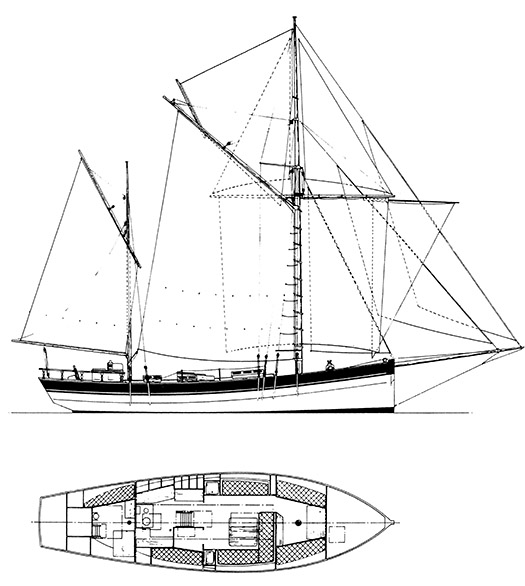
The Baltimore-built Saoirse. Conor O'Brien of Foynes was awarded the RCC Challenge Cup in 1923, 1924, and 1925 during his unprecedented global circumnavigation south of the great Capes in this 40ft ketch
More recently, Peter Guinness – originally of Howth – was awarded it in 1960 for an extensive cruise with the cutter Rob Roy McGregor, and then John Gore-Grimes from the same home port took it in 1985 for an exceptional Arctic cruise in the Nich 31 Shardana, the same skipper being honoured again for a long voyage north of Russia with the Najad 441 Arctic Fern in 2003.
Those who think the icy northern wastes are best left to polar bears will be cheered to learn that for 2014, I awarded the Challenge Cup to a sweet little own-built 34ft junk-rigged schooner which skipped across the oceans in the warmer zones like a flying fish. Then when she reached the end of each ocean voyage, her husband-and-wife crew would cruise each coastline visited as though that was the only cruise they'd be doing all year – in other words, with total enthusiasm and genuine interest in the people they met in some very obscure places.
But then, when you've a Jay Benford-designed Badger class schooner which you built yourself, you can comfortably fit in anywhere without offending the sensibilities of the locals by a gross display of affluence. Charlotte Waters – who is an artist – and her master craftsman/furniture designer husband Dan Johnson built their little boat Hestur with very limited resources near their cottage at Ullapool in Wester Ross in northwest Scotland. In their first season of 2013, they cruised to the Canaries via northwest Spain, then through 2014 they cruised on to West Africa and journeyed far up the Gambia River just before the outbreak of ebola, then went safely on their way to Cape Verde, across the Atlantic to cruise the Caribbean in detail, then on to Bermuda, the Azores, southwest Ireland, North Wales and so home to Ullapool leaving a very minimal carbon footprint in a voyage very worthy of the world's most senior cruising award.

Small and simple is beautiful and just right in a good cruising boat. Seen here far up the Gambia River in West Africa, this is the own-built Badger class schooner Hestur, whose owners Charlotte Watters and Dan Johnson of Ullapool in Scotland cruised extensively around and across the Atlantic. They have been awarded the RCC Challenge Cup for 2014. Photo: Charlotte Watters
RORC's 2015 Caribbean 600 Provides Variety of Yachting Teams
#rorc – The 7th edition of the RORC Caribbean 600 is looking like a real cracker and proving irresistible to a variety of yacht racing teams from all over the world. An international fleet of over 50 yachts has now entered the offshore blast around the Caribbean, indicating that last year's record entry of 60 yachts may be bettered. Yachts flying the flags of 13 different countries will be competing in this year's race: Antigua, Australia, Belgium, Canada, France, Germany, Great Britain, Italy, Lithuania, The Netherlands, Russia, Spain, and the United States of America.
The Caribbean is, without doubt, one of yacht racing's most exhilarating playgrounds with the warm trade winds and Caribbean swell providing superb sailing conditions. The RORC Caribbean 600 course, starting and finishing in Antigua, is designed to provide a challenging, high speed racetrack and its popularity has grown, year on year, since the first event in 2009.
Five battle for Line Honours
George David's Rambler 100 set the monohull course record in 2011, scorching around the track in 40 hours, 20 minutes and 2 seconds but this year's line-up is likely to be the most competitive for line honours so far. George David's brand new 88 ft Rambler will make its 600 debut with an all-star crew containing many of Rambler's old guard plus some new, world class, sailors including multiple America's Cup winner, Brad Butterworth and Volvo Ocean Race winners, Stu Bannatyne and Brad Jackson. Also in contention for line honours is Australian yachting legend Syd Fischer racing Ragamuffin 100, which is being shipped to Antigua from Australia, and Mike Slade's British 100ft Maxi Leopard, which took monohull line honours in the first edition of the race, makes a welcome return, and two Volvo 70s will also be vying to be the first yacht to complete the course, Giovani Soldini's Italian Maserati and Andrew Budgen and Fred Schwyn's British Monster Project.
Rambler's Project Manager, Mick Harvey, was full of excitement about the race: "George David has always been a strong supporter of this race because it is such a fantastic course with great conditions, but also because George David, like me and other crew, are members of the RORC and we just love to take part in this race. This will also be the first race of the Atlantic Ocean Racing Series, which is our priority for our first season. The boat is going well. As always there are a few adjustments, but all things considered, we are very happy with the new Rambler and looking forward to Antigua. This year there is a lot of good competition for us but we will concentrate on our own game, as that is all we can influence until the race start."
Hot Prospects for the RORC Caribbean 600 IRC Overall
Ron O'Hanley's Cookson 50, Privateer, was the overall winner under IRC in 2013 and the American team is back for their fifth race. Hap Fauth's American JV72, Bella Mente, has won her class before but will be setting their sights on the overall victory that has eluded the American Maxi 72, which has been second overall for the last two editions. American Reichel Pugh 63 Lucky, sailed by Bryon Ehrhart, will be making its debut in the RORC Caribbean 600, as will British TP52, Sorcha, sailed by Campbell Field. The all carbon German flyer Carkeek 47, Black Pearl, sailed by Stefan Jentzsch, will also be making its RORC Caribbean 600 debut.
Dutch grandmaster Piet Vroon is no stranger to the RORC Caribbean 600, having won IRC One on two previous occasions but the 2015 RORC Caribbean 600 will be the first offshore race for Piet on board Ker 51, Tonnerre 4.
"It is very exciting to be racing Tonnerre 4 for the first time and against different adversaries and it will probably be harder for us," commented Piet Vroon. "Tonnerre 4 will be much the same crew as we have had in recent years and I am looking forward to racing with them. I like offshore sailing and the RORC Caribbean 600 is a prime example. The route is very varied and no part of it is straight forward, with plenty of local weather effects which must also be considered during the race and the route is an interesting one, as we race around 11 islands. From a tactical and navigational point of view, this is very demanding. If you could import the same weather conditions for this year's Fastnet that would be great!"
Racing Schooners – Adela and Athos
Adela and Athos are spectacular and graceful from the days of old but are designed with innovative features and technology that exponentially enhances their speed and power to an incredible level.
The 203ft Schooner Athos and the 182ft Schooner Adela will be taking part in their third encounter in the RORC Caribbean 600. Adela has won the Spirit of Tradition and Superyacht Classes for the last three years, but Athos provided exhilarating competition last year, finishing less than 39 minutes behind, after two and a half days at sea. Adela's helmsman Stan Pearson, who was the co-founder of the RORC Caribbean 600, believes this year's battle between Adela and Athos will be even closer.
"In the last two races, Adela has sailed the best she could and didn't leave much on the track and this year I think it will be a right old ding dong," commented Stan. "Adela is now as good as she can be and the crew work on board is fantastic, so there is not much Adela can do to improve. Athos improved enormously last year and I expect her to be even better this year. Athos is longer than Adela and assuming a regular easterly, the course has 65% on eased sheets, which should be to Athos' advantage, the course is absolutely suited for big boats such as ketches and schooners."
Corinthian Battles
Of the 10 yachts currently competing in IRC One, the cosmopolitan entry list come from six different countries. On paper, two highly diverse American yachts should be the fastest around the course: New York's Jose Diego-Arozamena has been the proud owner of Farr 73, Maximizer, for over 20 years, racing in the Mediterranean, the East Coast of the USA and the Caribbean. Maximizer should be well matched with William Coates' Ker 43, Otra Vez, from Houston Texas, which has a proven track record, winning several prominent Caribbean inshore regattas.
In IRC Two Global Yacht Racing's First 47.7, EH01, will be taking part in the race for the sixth time. EH01 Skipper, Andy Middleton believes that the class favourite will be his good friend Ross Applebey, skipper of Oyster 48 Scarlet Oyster, which has won the class on two previous occasions.
"I sailed with Ross on Scarlet Oyster for the Rolex Middle Sea Race and we ended up without a rudder, lashed to a fishing boat in a full blown gale. In situations like that, you really find out who your friends are!" laughed Andy. "There are a number of race charter yachts in our class for the RORC Caribbean 600 and that really does make for a great competition between us. The course is a fantastic way to race around the central Caribbean, which is one of the most spectacular places to sail, anywhere in the world."
Under 40ft
Seven yachts of less than 40ft have already entered the race, proving that the RORC Caribbean 600 is not just for the Maxis. Local Antiguan, Bernie Evan-Wong, who has participated in every edition of the race, is back with a new boat, RP 37 Taz and a number of smaller yachts have sailed across the Atlantic to compete in the RORC Caribbean 600, including Louis-Marie Dussere's French JPK 10.10, Raging Bee, which won IRC Three and the Two-Handed Class for the 2014 RORC Season's Points Championship. Veteran RORC members Peter Hopps racing Sigma 38, Sam, and Peter Schofield racing HOD 35, Zarafa, will also be competing.
"This will be my third race but the first with Redshift and we will be a crew of six," said Nick Cherry. "It will be a tough race for us. The bigger, faster boats will get up on the plane and we will be displacing all the way around the course. However in IRC Three, we should have a chance and with so many corners, we hope to make gains because Redshift is easy to handle. Looking at all the 600 mile races, this is the course I would choose to do: plenty of fast sailing, loads of corners and lots of rocks to watch out for, so there is always something going on. I think we will have a flexible watch system as there will be plenty of sail changes and manoeuvres to nail. Compared to training in Brittany for the Figaro, with 10 degree water over your head, this race should be far more pleasant and this is the first part of our training for the Rolex Fastnet, which we will be doing Two-Handed. For the 600 we want to get round quickly, so we have plenty of time to enjoy the party afterwards."
Dublin Sailor Michael Boyd Named RORC Commodore in London
#RORC – Dublin Bay's Michael Boyd has been elected Commodore of UK's top offshore racing body, the Royal Ocean Racing Club (RORC). The 64–year–old Royal Irish Yacht Club sailor, a skipper in this year's winning Irish Commodore's Cup team, is only the second Irish sailor to lead the London club in its 89–year–history.
David O'Brien of the Irish Times has much more on the story in this morning's edition HERE.
RORC TransAtlantic Favourite Returns to Port With Broken Boom
#rorc – After leading the RORC fleet out of the Canary Islands yesterday afternoon the Finot-Conq 100, Nomad IV, sailed by Jean-Paul Riviere, was leading the race until gear failure forced the French Maxi to head back to the Canary Islands for repairs writes Louay Habib. All of the crew are safe and well. At about 2000 UTC on Monday 1st December, Nomad IV was approximately 110 miles south west of La Palma when the RORC Transatlantic tracker showed the boat had turned around and was heading back towards the Canaries.
The inaugural RORC Transatlantic Race, in association with the International Maxi Association (IMA), started on Saturday 30th November 1000 UTC from Puerto Calero, Lanzarote, Canary Islands bound for Grenada, West Indies, 2,995 nautical miles across the Atlantic Ocean.
At 2138 UTC, Nomad IV contacted the RORC Race Committee by satellite link to report that the boom of the 100ft Maxi had broken but that all were safe on board. The RORC Race Committee have remained in contact with Nomad IV and it is understood that the crew do not require assistance and plan to head back to the Canaries, probably Tenerife, to effect repairs.
Nomad IV was the hot favourite for Line Honours for the RORC Transatlantic Race to win the prestigious IMA Trophy and hopefully the team can effect a repair that will allow them to re-continue. However, the incident occurred over 100 miles out into the Atlantic and the French team will have virtually no chance of catching the front runners, even if a solution to the problem can be found quickly.
Nomad's misfortune means that at dawn on day three, the battle for the overall lead is between Jeremy Pilkington's RP78, Lupa of London and Russian Southern Wind 94 Windfall, skippered by Fabrizio Oddone. Windfall was 50 miles north of Lupa of London's position but in terms of distance to the finish, the two yachts are neck and neck. Windfall is positioned to skirt south around a high pressure system, which the Maxi will intend to slingshot around. Meanwhile Lupa of London seem to have taken a more conservative approach, keeping further away from the system and staying further south. The wind is due to veer east in the coming days and go lighter. If the wind does veer this will free off Windfall's angle before Lupa of London.
American Class40 Oakcliff Racing, skippered by Hobie Ponting, has had a great last 24 hours, sailing past Aref Lahham's Yacana in the early hours of this morning and at 0800 UTC was 11 miles ahead. However, Yacana, a classic Swan 68, is still estimated to be leading IRC One.
Currently 4th in IRC One, making 8.7 knots and 3 miles ahead of Sérénade, is the bright yellow Pogo 40, Bingo. One of four French teams in the race, Bingo is owned by husband and wife team from Paris, Isabelle and Yves Haudiquet and sailed with their long-time friends, Jean François Haupt and Pierre Crepin. Yves Haudiquet, from Yacht Club Paul Vatine, Le Havre, commented before the start: "I'm a lucky man with a 40ft boat able to surf day after day with the alizé (tradewinds) and with a motivated crew. My boat was built to compete in this sort of race and I'm hoping for a long surf ride and to increase the average boat speed from my last crossing."
Nigel Passmore's British J/133, Apollo 7 is currently leading IRC Two. The Plymouth team had an excellent night, blasting along under Code Zero to open up a 22 mile lead by dawn on Frank Lang's French X-40, Optim'X.
Follow the progress of the race via the fleet tracker: http://rorctransatlantic.rorc.org/tracking/2014-fleet-tracking.html
RORC Transatlantic Race Underway, Finally!
#rorc – After two delays to the start due to horrendous weather conditions, the RORC Transatlantic Race in association with the International Maxi Association started from Puerto Calero Marina at 1000 UTC, Sunday 30th November.
It was third time lucky as the RORC fleet departed Puerto Calero Marina, Lanzarote bound for Camper & Nicholsons Port Louis Marina, Grenada West Indies, 3000 miles away across the Atlantic Ocean. Rain squalls had been disturbing the air in the early hours of the morning, but virtually nothing would have prevented the eager fleet to set off on the inaugural RORC Transatlantic Race. Sunshine and a gentle northerly breeze prevailed for the start - the only abnormal weather feature was a perfect double rainbow, pointing the way to the turning mark off Marina Lanzarote, Arrecife - the only mark of the course before the fleet would make landfall in Grenada.
American Class40, Oakcliff Racing, skippered by Hobie Ponting, got away well and took an inshore line to take the lead. However, the young team from Rhode Island were soon overhauled by a trio of Maxi yachts; Jean-Paul Riviere's French Finot 100, Nomad IV, Russian Southern Wind 94, Windfall skippered by Fabrizio Oddone and Jeremy Pilkington's British RP78, Lupa of London.
The rainbow was not the only surreal experience at the start, a fleet of young Spanish Optimist sailors had decided to use the yellow inflatable turning mark for a training session. However, three loud blasts from the coach's whistle recalled the young sailors to a safe position, as humming deck gear and huge sail area, announced the imminent arrival of the Maxi fleet. No doubt the young sailors will tell the tale for years to come.
Five hours into the race, Nomad IV had rounded the southern tip of Lanzarote just ahead of Windfall and Lupa of London. Derek Hatfield's Canadian Volvo 60, Spirit of Adventure was leading the chasing pack. Frank Lang's French X-40, Optim'X showed impressive speed, making the turning mark in the company of Class40, Oakcliff Racing and ahead of Nigel Passmore's British J/133, Apollo 7.
Quotes from the start of the RORC Transatlantic Race:
Optim'X skipper, Frank Lang is taking part in his fifth Transatlantic race:
"I wanted to participate in this new RORC adventure and to share the experience with sailing friends," commented Frank. "We're looking forward to some fun racing and competition and to the long spinnaker surf rides bought on by the trade winds. It will be interesting to compare our result on corrected time with the big boats in the fleet."
Don José Calero, President Calero Marinas:
"It has been an absolute pleasure to see the impressive racing machines for this inaugural RORC Transatlantic Race in Puerto Calero. We have enjoyed hosting the crews and helping them to discover our incredible island of Lanzarote and we are pleased that they seem to have appreciated everything that Puerto Calero Marina has to offer."
"We would like to thank Eddie Warden Owen and the RORC team for choosing Puerto Calero for what we very much hope will become an established and popular annual event and we are already looking forward to next year for the second edition of the RORC Transatlantic Race."
RORC CEO, Eddie Warden Owen:
"Just over two years ago, the RORC decided to start a transatlantic race and it is just fantastic to see these yachts away. I am delighted to see a really co
mpetitive start. They were all pushing very hard, even though it is an endurance test for them, I am very proud to see them all going especially after the amazing weather we have had this week. The plan has come together, we have 11 boats for the first edition, but this race will grow and become a classic in the future."
RORC Admiral & Secretary General of the IMA, Andrew McIrvine:
"It is an impressive sight to watch the Maxis powering away. Once the breeze came up, the acceleration was absolutely phenomenal and they just sped away from the rest of the fleet and I am sure the Maxis will have a great battle. They have only been going for an hour, but they are already changing sails and employing boat-on-boat tactics and the lead has changed three times already. This is a perfect race for Maxis at a perfect time of year to cross the Atlantic in superb conditions to take part in the IMA Caribbean season."
RORC Transatlantic Race Suffers Second Postponement
#rorc – The start of the RORC Transatlantic Race has been further delayed due to adverse weather conditions. A further amendment to the Sailing Instructions was posted by the Race Committee delaying the scheduled start to 1000 UTC Sunday 30th November.
The Race Committee made the decision to postpone the start because the forecasted weather conditions for a decrease in wind as the day progressed has not materialised. In fact the wind has increased during the day to a steady 35+ knots with gusts in excess of 40 knots (and higher!) and the committee were concerned at the ability to lay a start line in the deep water off Puerto Calero Marina as well as the competitors' ability to manoeuvre safely in the confines of the marina.
The race will now start on Sunday 30th November at 1000 UTC.
O'Leary's 'Antix' Named RORC Yacht of the Year
#yachtoftheyear – The RORC Yacht of the Year, recipient of the Somerset Memorial Trophy for outstanding racing achievement by a RORC Member, has been awarded to Royal Cork's Anthony O'Leary's Ker 39, Antix, for 2014.
Anthony O'Leary did not enter any offshore races this year but his exceptional season in Antix, winning class in the RORC Easter Challenge, the IRC National Championship overall and being part of the winning Irish team in the Brewin Dolphin Commodores' Cup, was recognised by the RORC Committee as an outstanding achievement. O'Leary was disappointed not to be able to defend the Commodores' Cup victory of 2010 in 2012 but avowed to come back in 2014 with a competitive team and, by enlisting the support of Marc Glimcher's Ker 40, Catapult, and Michael Boyd and Niall Dowling who chartered Quokka 8, O'Leary crowned an already successful season with a consistent performance in Antix to win the Commodores' Cup.
Anthony O'Leary was thrilled with the news: "I must confess to complete surprise - and absolute delight for my crew!"
Read the full story about how Ireland won the Commodore's Cup in WM Nixon's interview with Anthony O'Leary.
The RORC Season's Points Championship consists of a selection of races, both UK and abroad, that test the skill and endurance of offshore sailors. In addition to the domestic season of 10 races, including the record-breaking Sevenstar Round Britain and Ireland Race, there were three races based overseas in 2014: the RORC Caribbean 600, Round Ireland Yacht Race and the Rolex Middle Sea Race. Whilst these longer races carry the highest points factor for the Championship, boats that do not travel outside of the domestic season still have a chance to win their class as only one high points factored race can count for the class trophies, with all other completed high points factor races reduced to a normal factor of 1.0. With this in place it is notable that this season the boats who successfully campaigned to win their class only competed in races with a points factor of 1.0 or 1.2.
Highlight of the domestic offshore season was the Sevenstar Round Britain and Ireland Race, a truly record-breaking race with five World and Race Records set in what transpired to be a challenging test of endurance in difficult conditions.
In total 360 boats competed in the RORC Season's Points Championship, a strong testament to the allure of offshore racing even in a year without the RORC's flagship offshore event, the Rolex Fastnet Race.
RORC Lifts 100–Foot Limit for Fastnet & Middle Sea Races
Fastnet – The 100 foot (30.47m) LOA monohull limit set by a number of the classic 600 mile races such as the Fastnet, Sydney Hobart and Middle Sea races has been lifted by the Royal Ocean Racing Club and the Royal Malta Yacht Club for the 2015 editions of the Rolex Fastnet and Rolex Middle Sea Races. This will allow superyachts participating in the Atlantic Ocean Racing Series to compete.
The AORS consists of four events: the RORC Caribbean 600, the 2015 Transatlantic Race from Newport to the Lizard, the Rolex Fastnet Race and Rolex Middle Sea Race. Superyachts have always been eligible to race in the RORC Caribbean 600 and a number have entered for the west to east Transatlantic Race at the end of June/July 2015, organised by the Royal Yacht Squadron and New York Yacht Club in association with the Royal Ocean Racing Club and Storm Trysail Club.
In previous editions of the Rolex Fastnet Race only monohulls of 100ft or less were eligible to win the coveted Fastnet Challenge Cup. In 2013 there were two monohulls at this upper limit of 100ft: Mike Slade's Farr 100, ICAP Leopard (GBR), and Igor Simcic's RP100, Esimit Europa 2 (SLO).
With a number of superyachts competing in the 2015 Transatlantic Race, such as Elena Ambrosiadou's, 289ft Dykstra/Perini Navi, Maltese Falcon, and Mariette, the 1915 Herreshoff classic, the increased LOA limit for the 46th biennial Rolex Fastnet Race will entice yachts over 100ft to enter and possibly win the Fastnet Challenge Cup, making for a spectacular race from Cowes, Isle of Wight in August 2015.
Rolex Fastnet priority for RORC members
"Another initiative in place for the Rolex Fastnet Race is to give RORC members priority when entering in January 2015," explains Nick Elliott, RORC Racing Manager. "The race was oversubscribed in 2013 within 24 hours of entry opening with many boats, including those of RORC members, having to go on a waiting list. To cope with demand, the Club increased the limit to 340, but with the 2015 Transatlantic Race from Newport to the Lizard having close to 60 boats and the Rolex Middle Sea Race breaking the 100 boat barrier, we can only envisage another scramble for places when entry opens at midday on the 12th January 2015," continues Elliott.
#rorc – The RORC Rating Office, the technical and administrative hub for all things Spinlock IRC rating-related in the UK, is re-badging its Limited Validity TCC (LV TCC) as the Single Event Rating (SER) with immediate effect.
The LV TCC scheme was an initiative launched two years ago as a means of introducing new owners to the benefits of racing under IRC without them having to apply for a full certificate. If owners only wanted to race in one or two events in the year they could apply for an LV TCC, with an upgrade to a full IRC certificate offered at a reduced rate.
The change of name is primarily being introduced to provide a more understandable and user-friendly path to build on the success of the past two years. 2014 saw 81 events accepting LV TCCs with 117 certificates being issued, compared with 54 events and 124 LV TCCs being issued in 2013.
A gateway into IRC racing
The newly branded SER is being rolled out to regatta and race organisers across the UK, with encouragement to include it in communications with their members and potential race and regatta entrants.
In spite of the LV TCC option already being widely available at club events and having been taken up by most major events over the past two years, the vast majority of interest has been from those run in the Solent region e.g. Aberdeen Asset Management Cowes Week, the J.P. Morgan Asset Management Round the Island Race and Panerai British Classic Week.
The LV TCC has given owners the opportunity for a memorable day or week of IRC racing at minimal cost. However, it is positive to note that a small number of boats that held LV TCCs in 2013 have upgraded to full IRC certificates in 2014 and as the Rating Office Technical Director, Mike Urwin, comments, "We may not yet be seeing vast numbers but it is satisfying to have made some converts."
He continues, "Noting the apparent strong Solent/major event bias, while the significant increase this year in the number of events accepting LV TCCs confirms that Clubs around the UK are keen to get more people racing, we recognise that many potential racing owners are not aware of the SER option, or the help and advice they can get from their local IRC Advocates or the Rating Office.
"We hope that the change of name will make SER more accessible and widely recognised, and. we will also be talking further to club officials and members at the regional level including seminars to be jointly held with the RYA this winter."






























